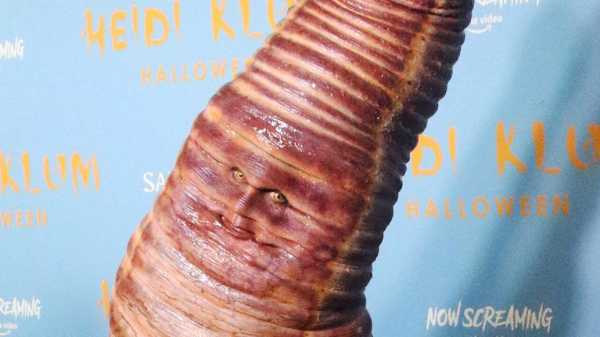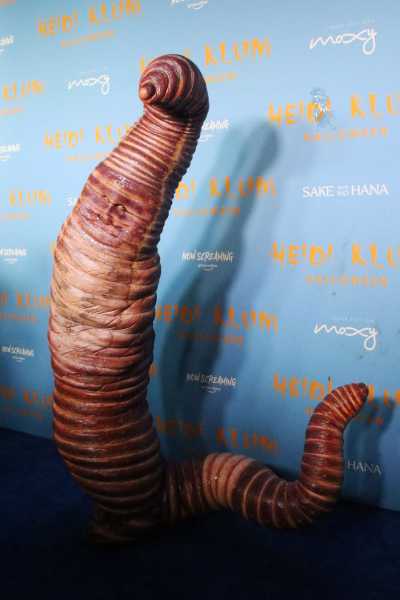

Heidi Klum’s choice to portray a worm has surpassed all her previous Halloween efforts.Photograph by Roger Wong / INSTAR / Alamy
On Tuesday morning, I was, as usual, on Instagram, scrolling through the previous night’s Halloween posts on my feed, when a series of images, from the New York Post account, stopped me in my tracks. What was I looking at, exactly? The pictures appeared to show a bulbous, enormous worm, ridged and glistening and pinkish brown, its tail elongated and tapering, its texture somewhere between that of an oily strip of bacon and offal that had turned. First the worm was standing on a red carpet, and then it was lying prone, as if flung from the set of a John Carpenter movie. (Steven Spielberg came to mind, too; my initial thought, upon seeing this horror, was this since-deleted viral tweet.) Disturbingly, the worm had a face, too, or at least eyes and lips, emerging wetly from the expanse of its tubelike body. As a video I watched later confirmed, the worm was also able to speak. A crouching “Entertainment Tonight” reporter proffered her microphone to the creature, whose mouth opened and closed with some difficulty, like a ventriloquist’s dummy. “Hi, guys!” it said into the mike, in a surprisingly girlish, German-accented voice. “Happy Halloween!”
The enormous worm wasn’t just any old enormous worm: within its prosthetic encasing was Heidi Klum, the supermodel and television personality, who has been known over the past three decades as a Victoria’s Secret Angel, a host of fashion-centric reality-competition shows such as “Project Runway” and “Making the Cut,” and, no less famously, a person who has been known to go really hard on Halloween. Throwing an annual star-studded Halloween party has been a Klum tradition for twenty or so years—a routine disrupted only by the pandemic—and, in the past, she has worn some extreme, labor-intensive costumes. In 2011, she was a hairy ape (a couple’s costume with her then husband, the singer Seal); in 2014, she was the whiskered, varsity-jacket-wearing teen werewolf of Michael Jackson’s “Thriller” video; and in 2018, she was Princess Fiona from “Shrek” (the green-skinned-ogre version of Fiona, of course).
Her choice to portray a worm, however, surpassed all her previous Halloween efforts combined. It was technically a couple’s costume; Klum’s husband, the musician Tom Kaulitz, dressed as a fisherman who had “hooked” her. But it was the worm that took center stage, and not just because of its sheer size (I’d estimate its height at seven feet and counting) but also because of the level of repulsion it inspired. “I want to unsee this,” my eleven-year-old daughter said, shuddering, when I showed her the images. It seems like this was basically what Klum was going for: as she told Vogue, “Because it is Halloween, you need the creepy factor, also a bit gross and disgusting.” But I also found that I couldn’t look away—a feeling that was obviously shared by many, as the pictures went viral immediately. The image in which worm-Klum is seen lying on the ground, immobile, with a microphone pointed at her, seemed to elicit special glee. (“This is how your email finds me,” one Twitter user captioned the image.)
Over the years, Klum has worn some more traditionally sexy costumes, too. In 2002, she was a buxom Betty Boop, and, in 2015, she was a va-va-voom Jessica Rabbit, getups that seemed to put her in line with that commonly held tongue-in-cheek truism from the movie “Mean Girls”: “In girl world, Halloween is the one night a year when a girl can dress like a total slut, and no other girls can say anything about it.” (The quote has recently become a popular TikTok sound.) But, even when wearing more revealing costumes, there has always been something cheerfully, grotesquely over the top about Klum’s choices, the high-femme-ness of the characters she picked to play accentuated by prosthetics or extreme makeup (huge, cartoonish brows for Betty Boop; fake boobs and a butt for the hourglass-shaped Jessica).
The glistening length of Klum’s earthworm, with its visual adjacency to both male genitalia and excrement, is surely far from femme-y. Vogue published photos of Klum in what she was wearing underneath the costume—a glittery bodysuit and spike heels—as if to reassure readers that the model’s world-famous curves were still there, hidden under her creepy-crawly covering. But the image of the worm was indelible: there was something disruptive, almost avant-garde, about its appearance on the red carpet, situated as it was between the weirdo vividness of “The Masked Singer” and the jovial abjectness of Viennese Actionism.
The fact that the whole stunt was enacted by a conventionally beautiful woman, too, was crucial and, honestly, inspiring. Klum, who is forty-nine, has long performed the role of a classic bombshell in her everyday professional life—just last month, she encountered backlash for posing alongside her eighteen-year-old daughter, Leni, also a model, in a sexy ad for the lingerie brand Intimissimi. But with her worm outfit it was as if, whether consciously or not, she was helping to underscore the endless heavy lifting that a certain kind of femininity requires. On the red carpet, the encased Klum went on to tell reporters that she wasn’t sure how she would be able to use the bathroom in her costume, a quandary that made me flash back to another moment of intimate discomfort, this one involving Kim Kardashian. In 2019, set to wear a heavily corseted, caramel-colored silicone dress, by the designer Thierry Mugler, Kardashian expressed concern that she wouldn’t be able to pee while wearing the gown. (Her plan: “If it’s an emergency, I think I pee my pants and then have my sister wipe my leg up,” she said.) “I have never felt pain like that in my life,” Kardashian told the Wall Street Journal, after the event, speaking of the indentations that the skintight dress left on her flesh. Klum’s costume, which took more than ten hours to put together, was “claustrophobic,” she told reporters. “It’s hard for me to move. I don’t really have arms or legs. When I fall over I need someone to help me get back up.” ♦
Sourse: newyorker.com






